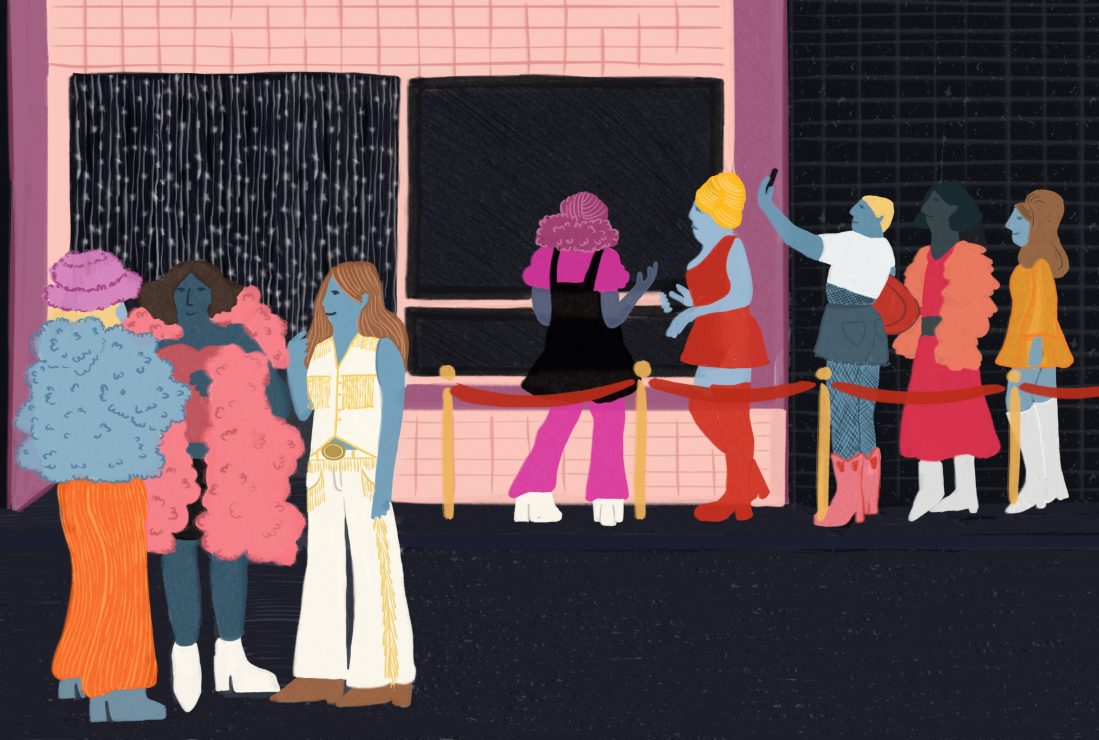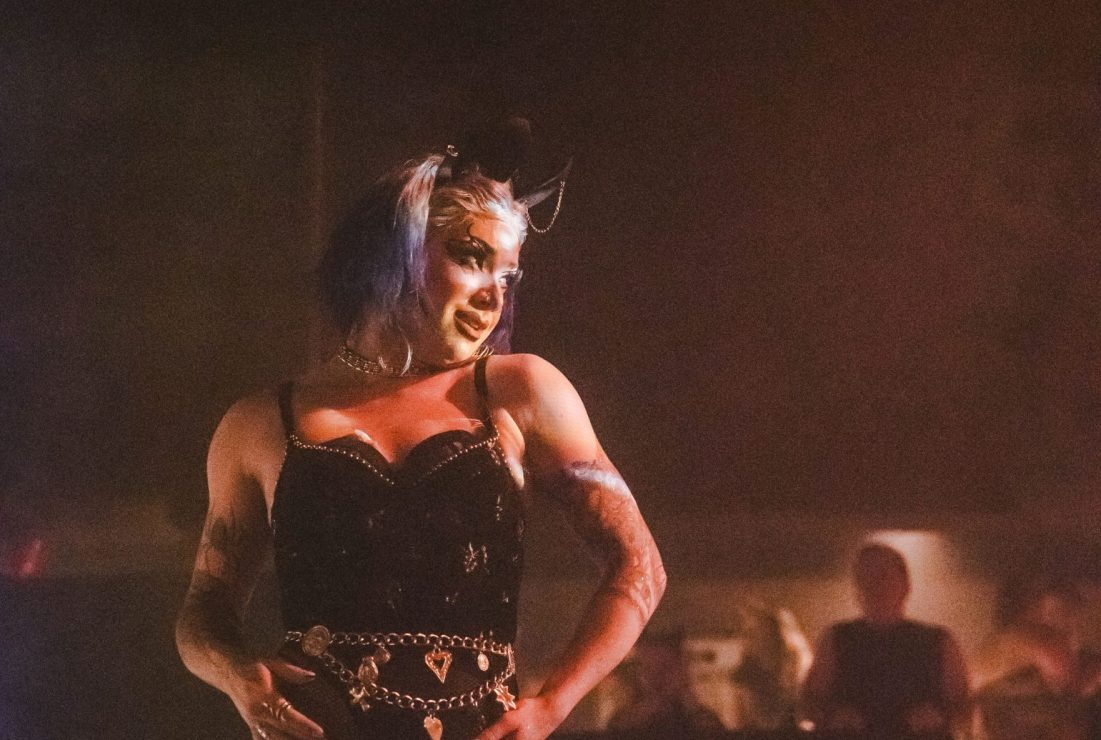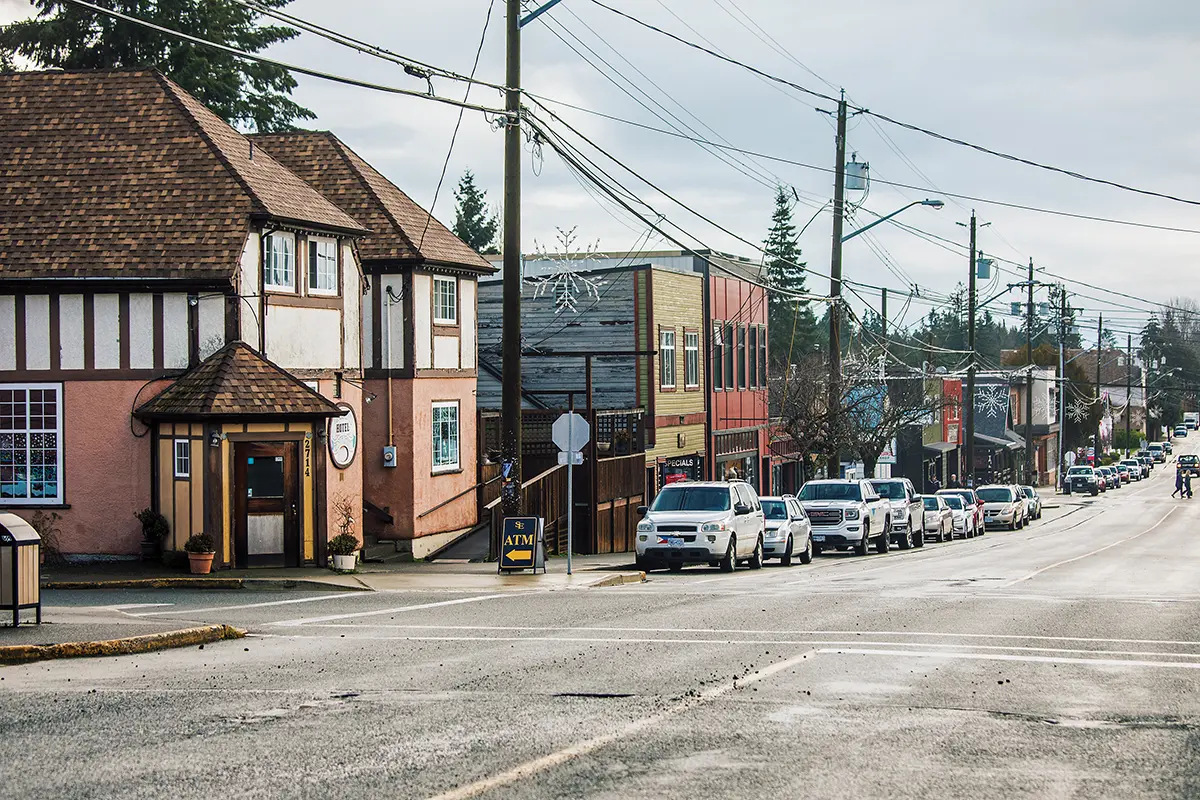Amid rising hate, safe, diverse spaces are essential

Illustration by Chloe Latour.
Pop music echoes through the street as we walk up to The Vicious Poodle, one of Victoria’s only gay bars. A waiter wearing a “faggots are fantastic” muscle shirt shows us to our table.
A vibrant drag queen stands on a stage in the corner of the room as music faintly plays in the back. She’s wearing a tight pink skirt and crop top with lace in between. Her wig is perfectly done up and her makeup completely transforms her face.
“Everyone knows if you tip a drag queen, you’ll have six years of good sex,” she says. “But if you don’t, you’ll have 12 years of bad sex!”
The basic pop music swells and she lip syncs the lyrics. She dances her way through the small space, holding a glittery rainbow bucket and shoving it in the faces of audience members. People throw bills in it as she struts around the bar.
After Victoria’s only gay club, Paparazzi, put its rainbow flags back in the closet, and with anti-LGBTQ+ rhetoric and legislation in Canada and the U.S. increasing, the city’s queer community is searching for safe, diverse spaces. Though not always safe from hate, drag shows like this one provide queer folk with much needed refuge and the opportunity to explore and embrace their identities.
History of drag
The concept of drag started as early as the 17th century during the time of Shakespeare’s plays. Women were not allowed to perform on stage, so men had to dress up and play the parts of women. The term “drag” first originated later, in the late 1800s, named after male performers’ petticoats, which would drag on the floor while they were on stage.
While men dressing up as the opposite sex is not new, it wasn’t until the late 1920s that drag was finally linked to the LGBTQ+ community. Since then, drag has become a staple in the queer community and it holds an important place in queer history.
In the 1950s and ’60s, drag performances toured around the States, though at the time, it was illegal to dress as the opposite gender. During the Stonewall Riots in 1969, drag queens were some of the first people to resist being harassed and discriminated against by the police, marking a turning point for the community.
Now, with Rupaul’s Drag Race hitting mainstream media, drag shows have only just begun to become popular, introducing not just queer people, but everyone to drag.
Drag and gender identity
UVic student Keelin Balla sits down in front of me, cross legged, drinking a bottle of lemonade. Balla first discovered drag around age 12 or 13.
“I had a vague idea that [drag] existed through other pop culture references,” Balla tells me. “But I watched Rupaul’s Drag Race and was like, ‘Oh my god, this looks so fun and cool,’ and that’s when I understood how big [drag] was.”
Balla moved to Victoria from a small town near Calgary to attend UVic in 2021. During their time here, they have come to understand their gender identity, and drag has given them opportunities to see people living outside of the gender binary.
“I’ve always known or at least felt that I was not cis,” they say. “My mom tells me this story about … how I would scream and cry and say, ‘I’m a boy, I’m not a girl.’ I wouldn’t wear any of the clothes that I had … So I’ve kind of always felt, and have known, that I’m queer.”
Growing up in Chestermere, Alberta, Balla didn’t see much in terms of gender diversity. While they had known from a young age that they were queer, Balla was unaware of the different ways they could express their gender identity.
It’s no surprise that media representation helps make marginalized demographics visible. But for the transgender community, representation is becoming more important than ever, especially with trans rights being rolled back in the States.
For Balla, Drag Race had a huge effect on them.
“Discovering drag… and seeing people who are existing outside of the conditions placed on them in an agender sense was really world changing for me,” Balla says. “With drag, it’s not binary. I knew trans people existed, but I always denied that is something I could be.”
Growing up, Balla had only heard of strictly binary trans identities, and didn’t know that they could exist outside of that framework. But they found that drag encompasses everything.
Ezra Lavender, also known by his drag name, Poptart, started his drag journey at the age of 20 when he entered a now-defunct pageant called Mr & Miss Gay Vancouver Island. Even though it was his first time doing drag, he took home the crown that night as a drag king. Since then, his drag persona and his life have evolved.
“Initially I was they/them, in drag or out of drag,” he explains. “I thought I had to be a king.”
Lavender started his full transition a year after starting his drag career. Since then his drag persona that started as an androgynous drag king has grown into the hyper-feminine queen Poptart is today.
“Exploring that femininity is natural and easy to me,” he continues. “It taps into how I really saw and what my relationship with femininity was. For a long time it was deeply performative.”
While being transgender and drag are completely different, trans performers have played a key part in the history of drag.
During the ’60s, when drag started to grow in popularity, many trans women became drag queens, as transphobia and homophobia made it hard for them to find work.
But even in the LGBTQ+ community, trans women who perform as drag queens have been criticized. In 2018, RuPaul said he “probably” wouldn’t have let popular queen Peppermint on the show if she had started gender-affirming surgery. But this seems to have changed in recent years, as season 14 of Rupaul’s Drag Race had the highest number of transgender drag queens yet.

Photo provided by Ezra Lavender.
Rising tensions
While drag performances are becoming more popular than they have ever been, there has also been a concerning rise in anti-LGBTQ+ rhetoric and legislation. Recently, certain states in the U.S. have implemented restrictions on healthcare for transgender people, criminalized drag performers, and have seen an increase of anti-drag hate and protests.
Canada is not safe from this anti-LGBTQ+ rhetoric either. Recently, Saskatchewan passed the “Parents’ Bill of Rights,” which means children under the age of 16 need parental consent if they want to change their pronouns or names, and Alberta is working on similar legislation.
Hate crimes are also rising fast for the queer community. Between 2019 and 2021, there was a 64 per cent uptick in hate crimes targeting LGBTQ+ people. Even safe spaces have been targeted. In 2022, around 30 drag events were threatened across Canada and Victoria was no exception.
That same year, Caffe Fantastico had to cancel its all-ages drag show, Sashay Café: Emo Edition, after an anonymous gun threat.
These threats had only been exacerbated since the Freedom Convoy, which flooded the streets across Canada in the summer of 2022. During this time, a user on the Ottawa Convoy Telegram channel, a popular app used by right wingers, warned against events like drag shows, saying, “We encourage you to keep an eye out for these events in your community and rally together to put [an] end to this abuse of the most vulnerable, our children.”
Even though Victoria has the highest proportion of trans and nonbinary people in Canada, queer people still feel unsafe.
“Safety concerns resonate really loudly within the community,” says Ace Mann, president of Victoria’s Pride Society (VPS). “It does feel scary right now, with the political climate in the U.S. and around the world. Things are going backwards and it’s hard to feel like that doesn’t have a ripple effect here.”
Queer spaces in Victoria
“[Queer spaces] are spiritual for me,” Mann says. “It feels rejuvenating, like a spa day for my soul. It’s something that I appreciate so much, to have that availability and to know that no matter what is going on, I feel safe and comfortable.”
These sanctuaries, however, can be hard to find in Victoria. After the popular club Paparazzi took down its rainbow flags, Friends of Dorothy and The Vicious Poodle have been left as the only openly LGBTQ+ bars.
“I can definitely see that it could be hard to know where to go,” Balla says. “It can be hard [to find events] if you’re not internet connected, or social media connected.”
These dwindling options have led to calls for more safe, diverse spaces for the queer community.
“We’ve got two bars … and both serve a different demographic of queer people or people who are supportive, and that’s great,” Mann says. “I also recognize that it only serves a handful of queer people. There are sober people who might not feel comfortable going.”
While there are no plans for another queer-friendly business to open in Victoria yet, Mann says that VPS is creating an online calendar to broadcast queer events around the city.
“We can’t reinvent the wheel, and we can’t do all those events that all these people are doing, but we can certainly amplify them,” Mann says.
They also have big dreams for the future of the queer community.
“I absolutely would love to have a small community center, or small building… that we could have events,” they say. “I would love to have a spot that is more accessible. Not just for people with disabilities, but accessible for different age groups and demographics.”
While this is currently just a dream, it’s shared by some.
“I think having designated spaces and advertised spaces, that are like ‘this is a queer space for queer people’ … is really important,” Balla says. “How else are you going to know where to meet other people like you and form those community connections, if there aren’t spaces that are outwardly saying they’re spaces for you?”
Back in The Vicious Poodle, pop music continues to blast through the speakers. The bar is full of people being themselves. There are queer couples holding hands, and people laughing with their friends, dancing, and singing. The waiter with the “faggots are fantastic” muscle tee grooves his body while making drinks.
The drag queen continues making her way through the entire, dimmed restaurant, shaking her sparkly rainbow bucket now filled with change. One table apologetically shakes their heads. Her eyes roll and she gently flips one of their phones, like a game of flip cup, continuing to mouth the song lyrics.
The energy in the room buzzes with excitement as the song winds down, and the space fills with applause. The queen takes a bow and walks away, leaving the entire bar wanting more.








